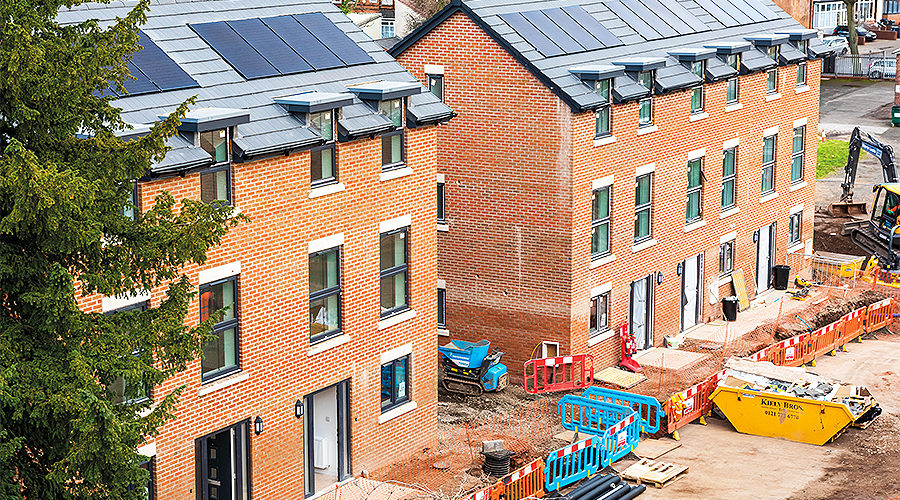Jenny Smith-Andrews, Head of Marketing at H+H, discusses how Project 80, a pioneering sustainable housing project, is paving the way for the future of UK homes with masonry construction.
H+H
Project 80 is leading the charge towards sustainable housing in the UK with the construction of 12 masonry homes that meet the Future Homes Standard (FHS) three years before it comes into effect.
In collaboration with Tricas Construction, Birmingham City University and industry suppliers, social housing provider, Midland Heart Housing Association, plans to build 80 homes that meet or exceed the 2025 FHS. This requires a reduction of 75 to 80% in carbon emissions over current standards.
H+H was happy to supply its aircrete blocks for the project’s first phase – building the initial 12 houses. The aim was to design standard housing using locally-sourced materials and labour, and compare the performance of different methods, materials and technologies to see which produce the best results at what cost.
The goal of Project 80 is to pave the way for the FHS by producing evidence to support the construction of the most sustainable and resilient homes.
Research and resilience
Birmingham City University is conducting the research. It tested each home’s energy efficiency pre-occupancy and will be monitoring how each home performs as residents move in and start to live in the homes.
Energy-efficiency standards required by FHS have been met by a combination of extremely high fabric efficiency and low-carbon heating. The technologies that are being trialled include air source heat pumps, solar panels, MVHR and more.
Along with the monitoring of the homes’ performance, several other research projects are being conducted in conjunction with Project 80 by PhD researchers. These include a study into air quality and airtightness as well as one looking into overheating.
These will be important studies to help understand how we can build homes that are not only sustainable now but will be resilient in the future. For example, overheating will increasingly become a problem as the effects of global warming worsen and average temperatures rise.
In masonry builds, the overall temperature is cooler as masonry blocks absorb heat in the daytime and release this stored heat during cooler night-time periods. Aircrete, in particular, with its high thermal mass is an excellent material to help mitigate overheating and regulate temperature extremes.
Project 80 also involves teaching and supporting residents to use the homes and new technologies in the most efficient way possible. For if we are to reduce the carbon emissions we and our homes produce, changing our behaviour is essential.
Key to supporting us in making these necessary changes will be constructing buildings that do as much of the work for us as possible. Project 80 has been planned with this in mind.
Fabric first
At the Project 80 launch event in March 2022, Tom Hall, Technical Design Manager at Tricas Construction, noted that the new masonry homes were designed with a “fabric-first approach”. The performance characteristics of the materials chosen for Project 80 are such that, no matter what heating solutions are installed, the buildings will be able to function as efficiently as possible.
This very much aligns with the ‘fabric-first’ approach to energy efficiency that H+H has always maintained. Our aircrete blocks help create efficient, airtight structures that can enhance the performance of energy-saving technologies like underfloor heating and air source heat pumps. The latter of which were installed in most of these first 12 homes.
Reassuringly, incorporating innovative design solutions and new technologies to the masonry structures, only resulted in a 15% cost increase on a traditional tender. Unsurprisingly, the cost of an all-electric scheme increased the cost of creating the site’s electricity infrastructure by 300%. However, this also meant that no gas supply was needed for the properties, avoiding the cost of installing gas mains entirely.
Looking to the future
The homes we build now need to be long lasting and sustainable, and when people talk about new technologies and sustainable housing, it is often assumed they mean modular construction or MMC.
Yet, if the Government is to meet its target of building 300,000 homes a year by the mid-2020s, then more traditional building methods will account for a significant proportion of these. This is why the initial phases of Midland Heart’s Project 80 combined new, sustainable technologies with brick and block masonry construction.
When planning Project 80, MMC methods like I-House (the offsite solution based on aircrete panels) were considered. But, given that brick and block construction is still more commonly used throughout the industry, it made sense to first try to understand how this can be optimised for the 2025 FHS.
Tricas Construction has said that MMC methods, like I-House, may be considered for later phases of the project. If this proves to be the case, H+H would be delighted to continue its involvement by supplying the Celcon Elements needed for the I-House system.
H+H has a track record of working collaboratively to achieve ever higher performance standards. As long ago as 2007, the company was involved in the first prototype zero-carbon homes. H+H also collaborated with several developers and the Building Research Establishment in the AIMC4 project to understand the impact of a fabric-first approach on energy-efficient homes.
It was, therefore, unsurprising that H+H was keen to get involved with a project that looked to not only pave the way for future construction, but also set an example for industry collaboration. Especially one that contributes to the vision of a better, more sustainable future with masonry building at its core.
To stay up to date with Project 80, visit the website below.










